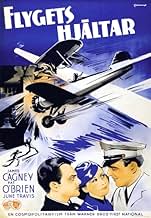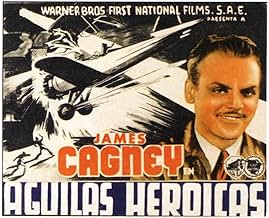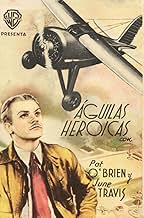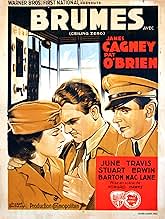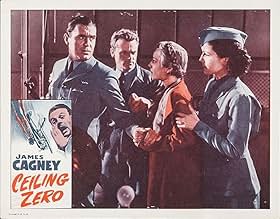War veteran pilots Dizzy Davis, Texas Clark and Jake Lee are working in an airline in Newark. Dizzy is flirting with the girlfriend of a younger pilot and, due to this, he feigns illness to ... Read allWar veteran pilots Dizzy Davis, Texas Clark and Jake Lee are working in an airline in Newark. Dizzy is flirting with the girlfriend of a younger pilot and, due to this, he feigns illness to get Texas to take his flight assignment to Cleveland. Returning from Cleveland to Newark, ... Read allWar veteran pilots Dizzy Davis, Texas Clark and Jake Lee are working in an airline in Newark. Dizzy is flirting with the girlfriend of a younger pilot and, due to this, he feigns illness to get Texas to take his flight assignment to Cleveland. Returning from Cleveland to Newark, Texas' plane crashes attempting to land on the airfield under extremely bad weather circum... Read all
- Awards
- 1 win total
- Smiley
- (as Dick Purcell)
- Transportation Agent
- (as Gordon Elliott)
Featured reviews
Hawks' preliminary study to "Only Angels Have Wings" is an absorbing aviator film which does not surprise very much though. A troup of airmen, intrepidly looking in death's eye, between the flight sequences, it's a drama of interiors. Duty and honor, lust and loyalty of professionals, a question of fast-paced flow of words and swifter movements. Hawks' (typical) flawed hero, played by the master of nimble gestures, James Cagney, is small and every handling an expression of his being. Although he flirts with June Travis and tries to impose his room keys on her, his love applies to his understanding chief and friend, the plagued Pat O'Brien.
Unfortunately, all this comes along as pretty conventional (particularly for a Hawks film), but is entertaining nonetheless with a great James Cagney in the lead.
Set in a small commercial airport (Newark) in the earliest days of commercial aviation, Ceiling Zero is about Dizzy Davis, an expert pilot with experience in The Great War who is as reckless as he is talented. He's hired back by his friend, Jake Lee, after a stint out West with stories of his outrageous behavior (including delaying the delivery of his mail cargo in order to land and hang out with four attractive women by a pool). Together with Texas Clarke, the three represent the last of a dying breed, the last of the pioneers of the skies who figured out flying through daring, experimentation, and war, steadily being replaced by the newer generation of college educated flyers.
Now, I do feel like the core of this movie is good enough and carries the overall film well, but it does, at the same time, leave a lot hanging without much payoff. One of those things is the pioneer versus educated divide. The early moments of the film are dominated by Jake firing a young pilot who abandoned his plane in the fog because he didn't have the nerve to take the blindness bravely, figuring out where he was relative to the airport and trying to land. This character disappears from the picture, and the movie never really makes anything of the comparison again, though we do see the nerve of the older generation in wonderful detail.
The other aspect of the film that seems only halfheartedly taken up is the love triangle. Dizzy meets Tommy Thomas, a young woman learning to fly who works at the airport. She has a beau, named Joe, but he's barely a character and appears only a handful of times, usually at the periphery of scenes until the end. It would actually be pretty easy for a viewer to miss the quick moment of Tommy with Joe near the beginning and assume that Dizzy is just courting Tommy without her having any previous ties. It kind of feels like there were some scenes cut somewhere along the way.
Anyway, Dizzy falls for Tommy instantly. How much is hard to say since he's been a womanizer for years, having broken romantic ties to Jake's wife that Jake doesn't know about. Still, he's going to make his effort with her, and in order to get his first date with her, Dizzy convinces Tex to take his flight to Cleveland and back that night. They have a nice time, but fog descends over Newark with zero ceiling on the ground. Tex can't see, makes his approach as best he can, but crashes horribly on the runway, dying in a fireball. Dizzy ends up consumed by his guilt, made all the worse by the fact that he couldn't help enough in the tower to get Tex down safely.
The aviation board in Washington ends up refusing to renew Dizzy's pilot's license, but he knows nothing else other than flying. With a storm front coming in, and emotions running high because of Tex's death, Jake leaves the airport and leaves Dizzy in charge, telling him to cancel the final flight of the night. This is where Joe becomes important, having developed a new kind of de-icing system for the planes and assigned the mission to fly that night. Dizzy, in charge and needing a way to make himself right with the world, refuses Jake's order to cancel the final flight, but instead of sending Joe, he knocks Joe out and flies up himself.
Now, when I saw this is bread and butter Hawks, I'm talking about how this repeats a lot of little plot points from before. In The Dawn Patrol, one character got another character drunk so he could fly the other's suicide mission. In Tiger Shark, one man gives up the woman he loves to another man she loves as his dying wish. In Today We Live, one man takes on a suicide mission because he knows that the woman will choose the other man over him. They're all variations on the same idea (I have no problem with this), and it's just that Hawks had his archetypes that he called upon repeatedly. It's a note, not really a criticism.
Anyway, Dizzy does the heroic and selfless thing, taking on the risk of providing the first real world test of the de-icing system, providing real world observation as his wings get more and more ice, recommending fixes that will make it work perfectly, before his plane becomes too heavy and falls to the earth. This is solid stuff, nothing terribly affecting or amazing, but well built and told. Joe needed to be more integral early, and the pioneer vs. Educated angle could have followed through by combining Joe with the early fired pilot. This might have provided enough material to really make the whole film more cohesive. However, the core of the film is Dizzy, and it's really good.
James Cagney was obviously more than just a mob tough from Little Caesar and The Big Heat, and he plays Dizzy with suave confidence and cockiness, making his quick courtship of Tommy believable. He's hot stuff as an ace pilot, and Cagney plays that really well. Props have to go out to the rest of the cast including Pat O'Brien as Jake, June Travis as Tommy smitten with Dizzy, and Stuart Erwin as Tex. It's a well-cast and acted film, made all the more important by the fact that about 75% of it takes place on a single set, the airport control tower. It's a strong mark in Hawks' favor that despite the limited locations (add in the bar set and you've got about 90% of your movie in two locations) it never feels small or repetitive. This is a case study in making the most of limited shooting locations.
It's a solidly good little drama, anchored by a very good performance by Cagney, but still open for a more streamlined script that took advantage of some of its more tangential ideas more. Still, it's a good little film in Hawks' very busy 1936.
Before the story gets underway, the opening title first explains the meaning of "Ceiling Zero - that time when fog, rain or snow completely fills the flyable air between the sky or ceiling and the Earth. Until recent years, no pilot dared to fly in ceiling zero weather." Set at the Federal Airlines in Newark, New Jersey, plot development focuses on Jake L. Lee (Pat O'Brien), a hard-driving field boss who must do what he has to do, ranging from firing those for not properly doing their job, or to later hire "Dizzy" Davis (James Cagney, sporting a mustache), an ace pilot under the better judgment of Al Stone (Barton MacLane), the company supervisor, With Jake and Dizzy being best friends for many years, he risks his career for his association with Dizzy. Dizzy isn't very well liked by his fellow flyers, especially Lou (Isabel Jewell), wife of "Texas" Clarke (Stuart Erwin), and by Tay Lawson (Henry Wadsworth), for forcing himself on Tommy Thomas (June Travis), a girl pilot whom he loves. Problems arise when Dizzy feigns illness to have Texas fly in his place in order to keep his date with Mary (Martha Tibbetts), one of his former girlfriends, now married Jake's wife. After Texas loses his life flying blind in ceiling zero, and being told off by Lou, Dizzy also risks losing both Jake's friendship and flying license as well. Co-stars include Craig Reynolds (Joe Allen), Richard Purcell ("Smiley" Johnson), Robert Light (Les Brogan), Addison Richards and Mathilde Comont. Garry Owen, not a very well-known character actor having appeared in numerous movie productions, stands out as Mike Owens, a former ace pilot reduced to shining door knows after a crackup that has deformed his speaking and memory ability.
With Cagney heading that cast, the film very much belongs to Pat O'Brien, whose supporting role is actually the lead. Cagney doesn't appear until 19 minutes into the story. His arrogant character comes similar to the latter Cagney-O'Brien collaboration of THE FIGHTING 69th (Warners, 1940) with similar results. Though CEILING ZERO doesn't contain better marque female names in support like Margaret Lindsay or a Glenda Farrell, the performances provided by the lesser known June Travis and Margaret Tibbets are commendable, especially Isabel Jewell coming off stronger than the major lead performers during its crucial scenes.
Ranked as one of the best of the aviation melodramas of the 1930s next to Hawkes own ONLY ANGELS HAVE WINGS (Columbia, 1939), CEILING ZERO, which did have television broadcasts in the past, has become strictly limited. In the early days of cable television, CEILING ZERO played on Showtime (1987) and Turner Network Television (1989-1992) before its distribution to video cassette in 1993. To date, CEILING ZERO has yet to broadcast on Turner Classic Movies or distribution on DVD due to legal complications regarding this title and its remake, INTERNATIONAL SQUADRON (Warners, 1941) starring James Stephenson and Ronald Reagan. Maybe like the obscure NIGHT FLIGHT (MGM, 1933) with John and Lionel Barrymore, CEILING ZERO may be seen flying across the screen of TCM in the future. For now, one would have to rely on the out of print 1993 video tape to locate and view out of curiosity's sake. (***1/2)
Hawks had a love affair with aviation films. He was an instructor for Signal Corps pilots during World War One, inspiring him to produce flyboy movies such as 1928 'Air Circus,' 1930 "The Dawn Patrol," and 1939 "Only Angels Have Wings," his last one containing similar storylines as "Ceiling Zero." Scriptwriter Frank 'Spig' Wead, also a WW1 aviator, wrote both the play of the same name as well as the script. Wead, an inventor for several airplane innovations, turned to writing when he became paralyzed falling down stairs while responding to his daughter's crying. The John Wayne movie, 1957's "The Wings of Eagles," directed by John Ford, is a biopic on Wead, who was good friends with the director.
Wead addressed two themes in "Ceiling Zero." Set in the year 1930, the movie focuses on the younger, yet vastly inexperienced pilots vying against the much older WW1 vets for aviator jobs. Dizzy Davis (James Cagney) and Tex Clarke (Stuart Erwin) are a pair of daredevil war pilots who fly in any type of weather, including ceiling zero, where visibility is nil. The younger pilots are skittish about the weather, as exhibited by one tenderfoot who abandons his plane when he can't see his hand in front of his face.
The secondary theme is the introduction of a novel form of deicing an airplane in flight when freezing rain, snow or drizzle dangerously forms ice on the airplane. Mixed in with all this excitement is cinema's proverbial romantic angle, which includes Jack Lee (O'Brien), who's the Newark, N. J. branch manager for Federal Airlines and a young female pilot "Tommy" Thomas (June Travis). Famous aviator Amelia Earhart gave lessons in flying, navigating and parachute jumping to Travis as well as to Cagney and O'Brien before the production in preparation for the film. Close to 70 per cent of the shots takes place in Jack's dispatcher office (filming never left the Warner Brother's studio and backlot.). Hawks's ability to create such a thrilling aviation film, all without computerized blue screens, was a talent very few movie directors in his day were capable of matching.
Did you know
- TriviaAfter the 1993 VHS release, legal complications reared their ugly heads, and this title was taken off the market; as a result there has, so far, never been a DVD release, and except for a single presentation in May 1994, it's never been broadcast on Turner Classic Movies. The remake, International Squadron (1941), also fell into the same legal quagmire and has never been released on VHS nor DVD nor aired on TCM. These are the only James Cagney and Ronald Reagan titles to remain legally unavailable for public viewing at this time.
- ConnectionsReferenced in Let's Stalk Spinach (1951)
- SoundtracksDear Old Pal of Mine
(uncredited)
Music by Gitz Rice
Lyrics by Harold A. Robe
- How long is Ceiling Zero?Powered by Alexa
Details
- Release date
- Country of origin
- Language
- Also known as
- Ceiling Zero
- Filming locations
- Production companies
- See more company credits at IMDbPro
- Runtime1 hour 35 minutes
- Color
- Sound mix
- Aspect ratio
- 1.37 : 1
Contribute to this page



